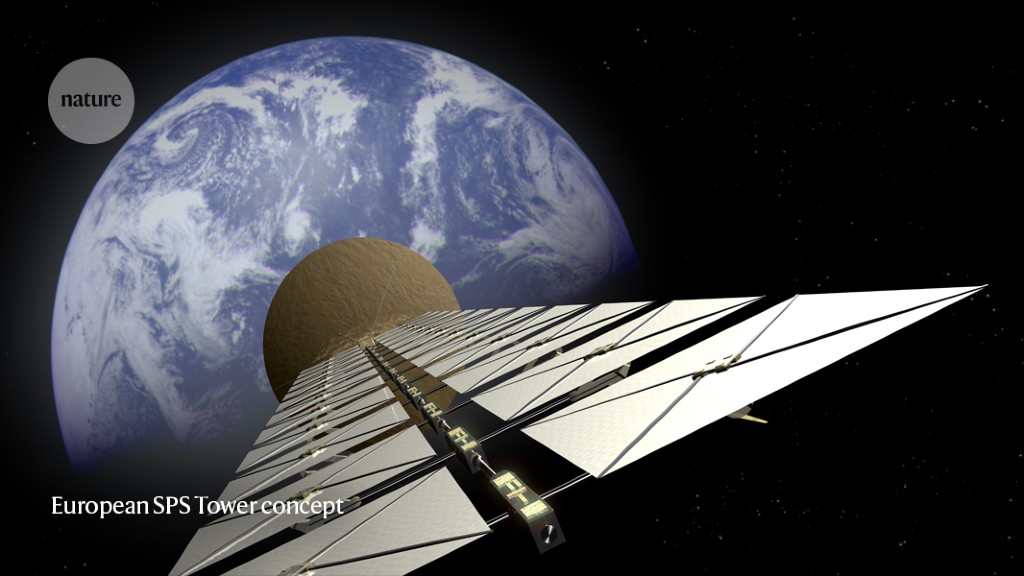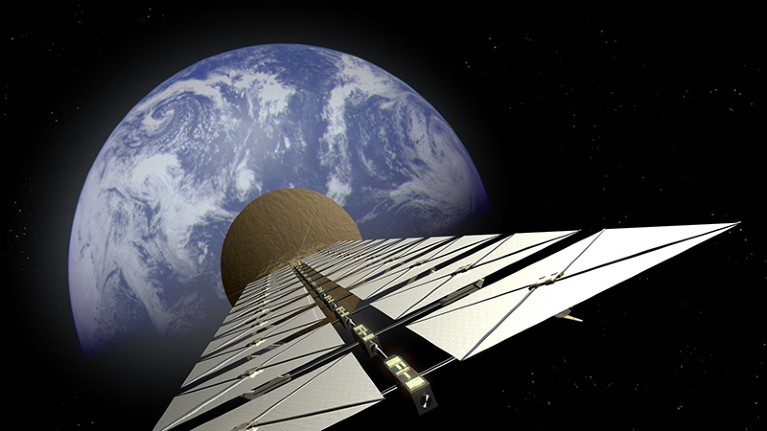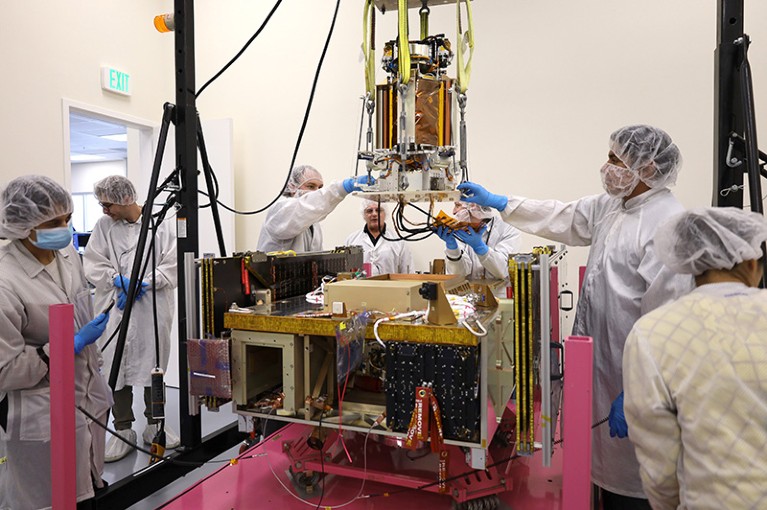The European Space Agency is investigating whether orbiting solar arrays could beam renewable energy to Earth, as shown in this artist’s illustration.Credit: European SPS Tower concept
For 100 years, people have dreamed of sending vast arrays of solar panels into space and beaming their energy down to Earth. Unlike intermittent renewable-energy sources on the ground, these orbiting panels would always bask in bright sunlight and would potentially offer a continuous supply of power.
Now such schemes are beginning to look possible, thanks to cheaper hardware and the falling cost of space launches. Teams around the world are working on key parts of space-based solar-power systems, and a prototype built by researchers at the California Institute of Technology (Caltech) should begin experiments in orbit this month.
“There’s nothing outlandish in this that would require new physics,” says James Carpenter, who co-leads the Solaris initiative, a feasibility study undertaken by the European Space Agency (ESA) that could lead to full development of the technology from 2025. “Economically, it’s comparable, for example, with nuclear power,” says Carpenter, who is based at ESA’s European Space Research and Technology Centre in Noordwijk, the Netherlands.
Space-based solar power would be viable only if it were implemented on a massive scale. Scientists anticipate building kilometres-wide arrays of solar panels that would orbit Earth at a distance of around 36,000 kilometres. The energy that they harvest would be converted to microwaves and beamed down to surface-based receivers with even larger physical footprints.
China has announced plans to put a megawatt-scale demonstration unit in low-Earth orbit in 2028, before deploying another system to a more distant geosynchronous orbit in 2030. Carpenter says that, with sufficient funding, the first multigigawatt solar power station could be operational by 2040. But despite the excitement, huge technical hurdles remain.
Nature looks at five big questions that researchers must answer to make space-based solar power a reality.
How can a solar farm be built in space?
To generate a gigawatt of power — comparable to the output of a power station on Earth — the orbiting arrays would need to be more than one square kilometre in size. That’s more than 100 times the size of the International Space Station, which took a decade to build. An array would be assembled in space from modules that could be mass-produced and launched separately. Caltech’s experiment will involve unfurling a tightly folded structure into a solar panel platform roughly the size of a dining table, but the modules in a full-sized array could be up to 60 metres long.
Other projects use different designs. Among the proposals ESA’s Solaris initiative is considering is a helical structure, and in Xi’an, China, Xidian University’s Chasing the Sun project is developing a crown-shaped solar collector. Both would require remote assembly by robots in orbit, a still-nascent technology.
The engineering behind such systems is “incredibly complex”, says Karen Jones, a space economist at the Aerospace Corporation in Arlington, Virginia. Caltech hopes to side-step this problem by flying its flexible panels in formation, without tethering them together, and using algorithms to correct for any fluctuations in position that affect power transmission. Whichever design is used, the components would need to be launched weekly, a rate that would be unprecedented, says Jovana Radulovic, a chemical engineer at the University of Portsmouth, UK.
What kind of solar cells would be used?
The solar cells need to be lightweight and efficient to keep launch costs down. Each kilogram of panel should produce 1–2 kilowatts of power, says David Homfray, a physicist who leads technical work at the UK’s public–private Space Energy Initiative. That power-to-weight ratio is around 50 times greater than for conventional silicon cells on Earth. Most designs aim to boost the solar cells’ exposure to sunlight using concentrators, mirrors and other innovative structures.
The cells will also need to withstand intense radiation in space. Yet the robust solar photovoltaic materials used in many space probes are too expensive to deploy in a huge array, so researchers need to know how cheaper alternatives will perform, says Radulovic.
To that end, an experiment on the Caltech prototype will trial 32 lightweight photovoltaic cells, including low-cost perovskites. “The idea here is to kind of do a longevity test,” says Ali Hajimiri, who co-leads the Caltech project.
Caltech researchers have built a prototype space-based solar power system that launched in January and is now preparing for tests in orbit.Credit: Caltech/Space Solar Power Project
How will the solar power reach Earth?
This is arguably the biggest challenge. Although laser beams transfer energy efficiently, clouds can block them. To avoid this problem, researchers hope to convert the solar arrays’ electricity into microwaves, which pass through the atmosphere without losing much energy. However, microwaves spread out as they travel, so engineers will need to carefully synchronize how the waves are emitted and use kilometres-wide receiving stations to collect them.
Converting solar energy into electricity, then into microwaves, and back into electricity on the ground, will inevitably incur some losses. “Nobody’s going to consider this idea seriously until those losses are significantly reduced,” says Radulovic. ESA estimates that only 10–15% of the solar power falling on a space array needs to be delivered to the electricity grid for a system to be economically viable. Yet achieving that would still require considerable advances in several energy-conversion technologies, the agency says.
Last year, researchers at Xidian University used microwaves to transmit solar power over 55 metres in a small-scale experiment on Earth. Using only conventional silicon cells, it achieved an overall efficiency of around 2.4%; the test marked the first time that the entire sequence had been demonstrated in a single system, says Xun Li, a researcher on the project. Caltech’s prototype will be the first space-based experiment to use microwaves to transmit and receive power, albeit across only 30 centimetres, adds Hajimiri.
Will it all be worth the effort?
Space agencies and nations think that space-based solar power might contribute to the goal of achieving net-zero carbon emissions by 2050. But “we have to prove this is going to actually be a net gain for the planet”, says Jones.
Space-based solar would certainly be much more expensive than terrestrial solar power. However, it could rival the costs of other sources of continuous low-carbon power, such as nuclear or gas with carbon-capture technology, says Carpenter — although more-economical ways of storing renewable electricity on the ground could diminish the case for a space array.
Meanwhile, researchers at the University of Strathclyde, UK, have calculated that it would take less than six years for a space-based solar-power station to offset the greenhouse gases emitted by developing, building and installing the project. “It looks really, really competitive,” says Homfray. Still, Radulovic questions the reliability of such estimates, given the uncertainties about how these systems will be designed and deployed.
Will it be safe?
Beaming microwave energy from space is surprisingly safe. The beam’s frequency will be chosen so that it does not disrupt aircraft communication. And because its power would be spread over such a wide area, the average energy density received by ground stations would be around 50 watts per square metre, says Carpenter, equivalent to the harmless level of microwaves that can leak from a microwave oven. “It’s within what would be considered a normal safety recommendation for human exposure,” he says.
But researchers will need to prove that there are no adverse effects on humans, animals or the wider environment. “I think they need to take the lead from the mobile-wireless industry that went through the same concerns, and to not trivialize these concerns, but prove it with studies,” says Jones.









More News
Judge dismisses superconductivity physicist’s lawsuit against university
Future of Humanity Institute shuts: what’s next for ‘deep future’ research?
Star Formation Shut Down by Multiphase Gas Outflow in a Galaxy at a Redshift of 2.45 – Nature